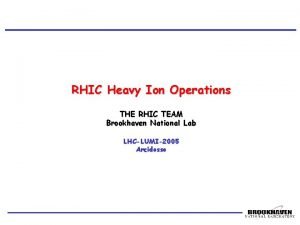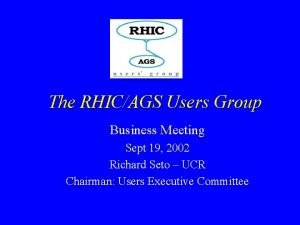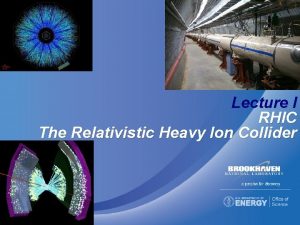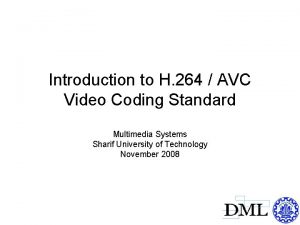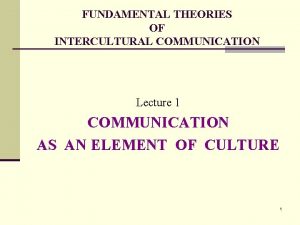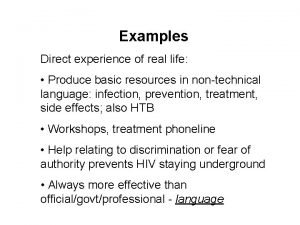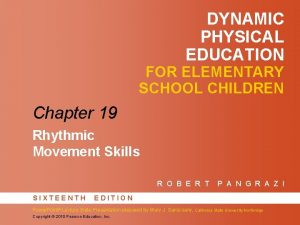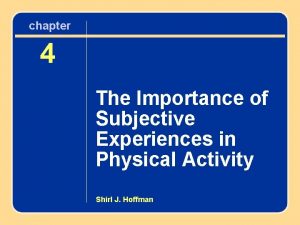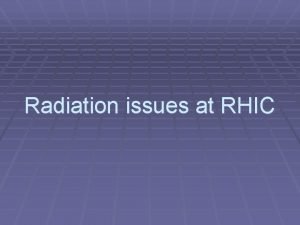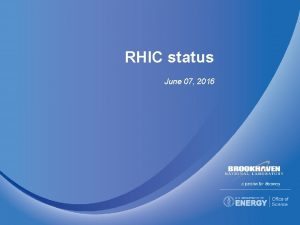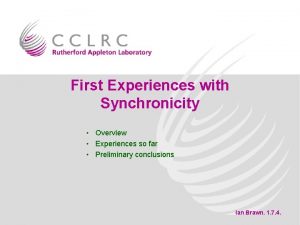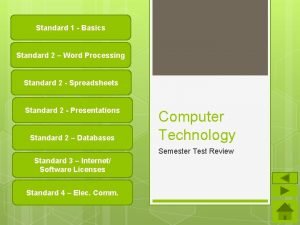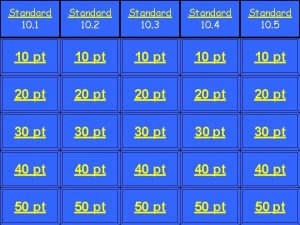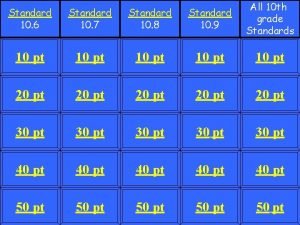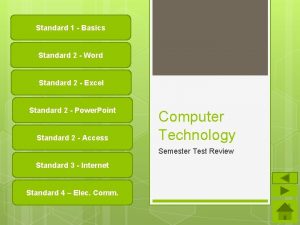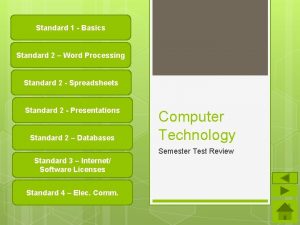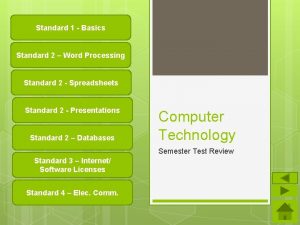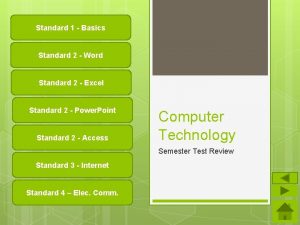RHIC experiences and challenges Overview RHIC Experience standard






















![RHIC triplet vibration feedback ZDC coincidence rate [k. Hz] ZDC rates at PHENIX and RHIC triplet vibration feedback ZDC coincidence rate [k. Hz] ZDC rates at PHENIX and](https://slidetodoc.com/presentation_image_h/0e49be86c8cee1f74b99897e66509dfc/image-23.jpg)


















![RHIC tune and coupling feedback run-9 without feedback time since start of acceleration [s] RHIC tune and coupling feedback run-9 without feedback time since start of acceleration [s]](https://slidetodoc.com/presentation_image_h/0e49be86c8cee1f74b99897e66509dfc/image-42.jpg)

![Ramp Optics Measurement b-function [m] model versus measured by at IPM time since start Ramp Optics Measurement b-function [m] model versus measured by at IPM time since start](https://slidetodoc.com/presentation_image_h/0e49be86c8cee1f74b99897e66509dfc/image-44.jpg)


- Slides: 46

RHIC experiences and challenges • Overview • RHIC Experience - standard diagnostics and their evolution • RHIC Challenges - standard diagnostics and their applications - how challenges defined diagnostic developments - how these developments were applied • RHIC Major New Accelerator Technologies • Summary Michiko Minty Beam Dynamics meets Diagnostics 4 -6 November, 2015

2 superconducting 3. 8 km rings 2 large experiments 100 Ge. V/nucleon ions up to U 255 Ge. V polarized protons performance defined by 1. luminosity L 2. proton polarization P 3. versatility (species, E) RHIC commissioning era (2000 to 2002) reached Au design energy and 75% of design luminosity first 100 Ge. V polarized proton run RHIC-I era (2003 to 2013) reached 15 x Au+Au design luminosity stochastic cooling beginning in 2007 steady increase in bunch intensity long full energy (250 Ge. V) polarized proton runs RHIC-II era (2014 to present) EBIS 2014: full 3 D cooling for Au (and other species) 2015: electron lenses for head-on beam-beam compensation 2016: new 56 MHz superconducting cavity for additional longitudinal focussing

Standard diagnostics and their evolution in RHIC: beam positions and profiles

RHIC BPMs - commissioning era technical issues: thermal retraction of SMA center conductor and thermal stress at solder joint (cables then crimped, 2001 -2002) susceptibility of electronics to radiation (so relocated, 2002 -2004) relays and opto-couplers not reliable (removed, 2005) measured orbit spectra blue ring beam issue: triplet vibrations (applied 10 k-turn average orbits, 2001) yellow ring RHIC BPMs - RHIC-I era beam position [mm] applied digital equivalent of a single-pole, low pass filter (IIR filter) to effectively average out predominantly ~ 10 Hz variations in the closed orbit (2009) yold Xold ynew Xnew C. Montag et al, Observation of helium flow induced beam orbit oscillations at RHIC, NIM A 564, pp. 26 -31 (2006) (here “old” refers to 10 k-turn average orbit measurement) precision of average orbit measurements improved by > factor 10 R. Michnoff et al, “RHIC BPM average orbit calculations”, PAC 09 (TH 5 RFP 013)

sign of BPM survey offsets changed (2010) in support of orbit feedback development (2010): average orbit BPM data acquisition rates < RUN 10 acquisition rate: nominally 0. 5 Hz nondeterministic (“stale” data delivered) RUN 10 acquisition rate: 1 Hz deterministic after BPM FEC and ADO code changes, average data delivery rate reduced to 150 ms (suitable for orbit feedback at 1 Hz rate). M. Minty et al, “Global orbit feedback in RHIC”, IPAC 10 (MOPEC 029)

RHIC profile monitors 1. Ionization profile monitors (utilizing rest gas) applied for injection matching (during early commissioning) normalized emittance [mm] used for routing monitoring of beam size evolution applied to detect electron cloud induced instabilities at transition crossing (~ 2005) R. Connolly et al, Residual-gas-ionization profile monitors in RHIC, PAC 05 (TOPC 002)

2. Vernier (Van Der Meer) scans Zero degree calorimeters (ZDCs), used as luminosity monitors and for luminosity optimization, are used to measure the effective beam size by measuring interaction rates as a function of transverse separation (standard approach). C. Adler et al, NIM A 470 (2001) 488 -499. 250 Ge. V protons single-Gaussian fit double-Gaussian fit A. Drees, Emittance measurements using Vernier scans during run 09 (pp at 250 Ge. V), C-A/AP/#412 (2010) During RHIC commissioning and RHIC-I eras, emittance measurement comparisons (Vernier and IPM) were larger than expected. This motivated future studies and developments.

3. Fluorescence monitor (jet) video image fitted projection The polarized atomic hydrogen gas jet, which is part of the polarimeter, was imaged for use as a beam profile fluorescence monitor yellow beam blue beam (decay of metastable state of H) emittance comparisons with IPMs s (mm) b (m) ge (mm) ~10% ~30% T. Tsang et al, Optical beam profile monitor and residual gas fluorescence at the relativistic heavy ion collider polarized hydrogen jet, Review of Sci. Instruments 79, 105103 (2008)

4. (movable) Schottky monitor bellows Schottky and background spectra acquired during normal operations data and fits K. A. Brown et al, Measuring transverse beam emittance using a 2. 07 GHz movable Schottky cavity at the Relativistic Heavy Ion Collider, Phys. Rev. ST Accel. Beams 12, 012801 (2009)

5. Wire scanner, fiber of CNI (Coulomb-nucleon interference) polarimeter bunch-by-bunch measurements (2008) beam size [mm] injection store bunch number often convincing profiles, good relative measurements 2013 issue - broken fibers, added video imaging: this approach for beam profile measurements not further pursued

RHIC Challenges – standard diagnostics and their application: beam emittances and linear optics

RHIC-I era: emittances derived from beam profile measurements disparity between methods in reported emittances A. Zelenski, “Emittance measurements at RHIC” APEX Workshop (2008) In addition, beta- and phase beating errors were measured with amplitudes much larger than expected based on estimates of plausible magnetic field errors Major developments in linear optics studies: commissioning (1) Turn-by-turn BPM precision – hardware (2) Turn-by-turn BPM precision – demonstration RHIC-I (3) Local coupling correction (4) Lattice implementation RHIC-II

RHIC-I era experience: turn-by-turn BPM measurements For beam optics measurements, in addition to hardware status checks, statistical analysis methods (SVD and FFT) had to be applied to pre-screen BPM data. R. Calaga and R. Tomás, Statistical analysis of RHIC beam position monitors performance, PRSTAB, Vol 7, 042801 (2004) During the shutdown prior to run-11, tested digital aspects of data delivery by sending a pre-defined sequence of values and reading these back to check data array alignment sent less received value sent value Numerous hardware improvements resulted: example BPM errors array element errors eliminated by staggering TBT data delivery on IEEE serial bus interface (“Fire. Wire”) and by basing timing delays on the beam sync link turn counter (instead of software delays) no errors after >100, 000 acquisitions (1 acquisition = ~650 BPMs * 1024 values) ~ 100 billion readings

enabled high quality beam optics measurements (next dominant contribution to error bar size suspected to be due to decoherence) phase beat [Q units] 2009 2011 note change in scale yellow ring p, 250 Ge. V longitudinal position [km] yellow ring Au, 100 Ge. V longitudinal position [km] R. Calaga et al “Chromatic measurements in RHIC and LHC”, Optics Measurements, Corrections and Modeling for. High-Performance Storage Rings Workshop, CERN (06/2011)

< 2012 FFTs and SVD methods used for beam optics measurements puzzle: large beta- and phase-beating (suspected to be due to “bad BPMs”) 2012 motivated by quantifying phase measurement accuracy and precision of E-Lens phase shifters, new approach for data analysis applied: least squares fits in the time domain (with exponential fits) rms of (data minus fit) at each BPM after kick excitation blue ring horizontal yellow ring horizontal blue ring vertical yellow ring vertical position rms [mm] longitudinal position [m] ~ 20 mm precision of turn-by-turn BPMs demonstrated, vertically ~ 30 mm precision of turn-by-turn BPMs demonstrated, horizontally (far better than expected) difference due to real orbit variations resulting from triplet vibrations “reinvigorated” beam optics studies with now demonstrated precision input measurements P. Thieberger et al, unpublished

Local coupling correction at RHIC skew quadrupole topology LOCAL Important because optics corrections schemes did / do not consider influence of coupling RHIC commissioning era: coupling found to be excessive, localized to triplet quadrupole rolls GLOBAL RHIC-I era: determined that dispersion hy was introduced by global decoupling and that global decoupling was correcting for triplet rolls (local coupling) measured hy (red) and calculated hy generated by correctors (blue) measured hy (red) and calculated hy generated by skew quads (blue) C. Liu et al, “Simultaneous dispersion and coupling correction in RHIC”, NIM A 750 (2014) pp. 56 -60 revisited local coupling correction at triplets (24 triplets: 12 per ring)

Result: local skew quadrupole strengths after implementation of corrections: A. Marusic (unpublished) Result: measured R-matrix elements (ORM - Orbit Response Matrix - method) before local coupling correction (2010) after local coupling correction (2012) R 14’s ~ 0 R 34 R 14 y-COR R 12 R 32’s ~ 0 y-BPM T. Summer’s (unpublished) x-COR x-BPM coupling corrections previously in conflict. Now, both local and global correction corrected locally. Methodology applied for local coupling correction: F. Pilat, “Correction of triplet skew quadrupole errors in RHIC”, RHIC/AP/58 (1995)

RHIC-II era: IPMs versus ZDC-derived emittances ZDCs – red and black IPMs – other colors FY 11: 100 Ge. V Au+Au Fy 14: 100 Ge. V Au+Au (3. 5 hours full scale) absolute emittance measurements in RHIC, consistency between IPMs and ZDCs M. Minty et al, Absolute beam emittance measurements at RHIC using ionization profile monitors, IBIC 14 (MOPF 09)

RHIC Challenges – how these defined diagnostic developments: feedback systems

RHIC tune and coupling feedback development initiated as US-LARP proposal (FY 03) with joint agreement BNL/FNAL/LBNL/CERN (FY 05) tune measurement – BBQ method (M. Gasior and R. Jones) coupling measurement – using methodology of coupling angle measurement (Y. Luo et al) feedback design – uses eigenmodes for handling betatron coupling (O. R. Jones, P. Cameron and Y. Luo) demonstrated in RHIC in 2006 (P. Cameron et al) made operational in 2009 following changes including: accuracy - by removal of data corruption (due to CPU limits and data overwrites) precision – by using all available data 8 periods 1 period used for BBQ/BTF 8 periods 1 period used for BBTF ………………. …. . . (repeat) ………. . … 1 (possibly corrupted) period used BBQ/BTF

RHIC orbit feedback motivated by observed trajectory drifts orbit measurement based on existing infrastructure (BPMs and networking) using improved algorithm for measuring average orbit and original survey (offset) data deterministic data delivery feedback design orbit correction algorithm: SVD (singular valued decomposition) extended to application at 1 Hz rate during energy ramp Mij x x = M q x = vector of ~ 320 BPM measurements M = matrix of transfer functions Mij is the transfer matrix between the ith BPM and jth corrector dipole q= vector of angular deflection of ~ 230 correctors Dq = M-1 Dx demonstrated in RHIC in 2010 made operational in 2011 following changes for handling off-energy beams: constrain average horizontal corrector strengths use all arc BPMs for energy offset determination (for eliminating dispersive contributions to orbit)

RHIC triplet vibration feedback motivation: (1) prevented operation at near-integer tunes (2) modulated crossing angles at IPs (3) caused modulated betatron tunes collision point triplet x (mm) triplet time feedback design uses existing BPMs with new fast readout and new dedicated correctors SVD correction algorithm prototyped in RHIC in 2010 implemented in RHIC (at store) and extended to application during acceleration in 2011 R. Michnoff et al, RHIC 10 Hz global orbit feedback system, IPAC 10 (MOP 268)
![RHIC triplet vibration feedback ZDC coincidence rate k Hz ZDC rates at PHENIX and RHIC triplet vibration feedback ZDC coincidence rate [k. Hz] ZDC rates at PHENIX and](https://slidetodoc.com/presentation_image_h/0e49be86c8cee1f74b99897e66509dfc/image-23.jpg)
RHIC triplet vibration feedback ZDC coincidence rate [k. Hz] ZDC rates at PHENIX and STAR higher integrated luminosity feedback on 2011 time [hrs] without 10 Hz feedback blue ring yellow ring vertical horizontal with 10 Hz feedback vertical horizontal vertical intrinsic resolution (versus 10 Hz interferences) of instrumentation now observable

RHIC Challenges – how these developments were applied

Allowed operation under extreme conditions 7/10 snake resonance end of acceleration start of acceleration 2/3 resonance DQy= 0. 006 time since start of acceleration [s] avoidance of depolarizing snake resonance by acceleration in close proximity to strong orbit resonance

Consequently increased accelerator performance run-9 run-11 figure from M. Bai et al, “Status and plans for the polarized hadron collider at RHIC”, IPAC 13 (TUYB 203) ~ 25 % increase in relative polarization of each beam huge figure of merit increase (LP 2 / LP 4 for transverse/longitudinally polarized beams)

Enabled otherwise not practical/possible experiment: acceleration and deceleration with orbit, tune/coupling and chromaticity feedback main dipole current [A] total charge [1011] motivation: cross-calibration of polarimeters at 250 Ge. V time [hrs] action of feedback loops: acceleration deceleration absolutely critical for successful execution

Ramp Optics Measurement and Correction motivation: improve understanding of emittance evolution during acceleration correct optics during acceleration cycle strategy: orchestrate data acquisitions and data delivery using interleaved average orbit BPM measurements (for orbit feedback) and turn-by-turn BPM measurements (for optics measurements) 1. 4. trigger 1 Hz event for orbit feedback ping beam in vertical plane 5. acquire TBT BPM data ping beam in horizontal plane deliver data acquire TBT BPM data deliver data 2. acquire and deliver BPM data for orbit feedback 0 repeat 200 trigger turn-by-turn BPM 3. data acquisition 1000 time (ms)

Luminosity leveling with dynamic b*-squeeze initial condition: corrected optics to Db/b < 10% (peak-to-peak) stochastic cooling increases instantaneous luminosity implement dynamic b*-squeeze luminosity leveling at STAR experiment lattice without b*-squeeze lattice with b*-squeeze G. Robert-Demolaize, The luminosity upgrade at RHIC, IPAC 15 (FRXC 1)

Major New Accelerator Technologies Developed at RHIC

Motivation: intrabeam scattering (IBS) causes emittance growth of heavy ion beams RHIC-I experience: an “IBS suppression lattice (ibs-s)” was applied in run-8 which successfully reduced emittance growth however not without operational difficulties (beam loss at rebucketing / off-momentum dynamic aperture) figure from V. Litvinenko, “Experience with IBS suppression lattice in RHIC”, EPAC 08 (WEPP 015) ge [mm] Bunched-Beam Stochastic Cooling time [s] V. Litvinenko et al RHIC-II upgrade included ultimately full 3 D, bunched beam stochastic cooling (2014) average luminosity vs. vertex size 2016 with 56 MHz SRF L +30 -50% demonstrated 2014 full 3 D cooling demonstrated 2011 long. + ver. cooling calculations by M. Blaskiewicz, J. M. Brennan and F. Severino, Operational stochastic cooling in the Relativistic Heavy Ion Collider, PRL 100, 174802 (2008) M. Blaskiewicz, J. M. Brennan and K. Mernick, Three-Dimensional Stochastic Cooling in the Relativistic Heavy Ion Collider, PRL 105, 094801 (2010)

RHIC-II Electron Lenses for head-on beam-beam compensation New lattice (ATS type, S. White) – phase advance kp between IP 8 and e-lens minimizes beam-beam resonance driving terms Electron lenses – reduce beam-beam induced tune spread Tune width measurement: imaginary part of complex beam transfer function (BTF); p+Al – no coherent bb modes DQ reduction from e-lens New lattice has larger off-momentum dynamic aperture and accommodates higher beam-beam parameter x 2 x bb no bb xmax = − 0. 011 per IP (RHIC in operations, to date) W. Fischer et al, Operational head-on beam-beam compensation with electron lenses in the Relativistic Heavy Ion Collider,

RHIC-II electron back-scattering detector (e. BSD) ELECTRON GUN simulated trajectories for electron-proton beam alignment in-air scintillator detector e. BSD rate Van Der Meer scans Ie [m. A] Nppb [1011] use during operations time [s] P. Thieberger et al, High energy Coulomb-scattered electrons for relativistic particle beam diagnostics, submitted to PRSTAB (2015)

RHIC-II Era Performance: with full 3 D Stochastic Cooling for ion beams with Electron Lenses for polarized proton beams Run-14 Run-15 Au+Au luminosity from Run-14 exceeds all previous Au+Au runs combined courtesy W. Fischer Run-15 integrated luminosity at √s = 200 Ge. V exceeds sum of all previous runs

Summary

Summary – what worked, what needed further developments commis- RHIC-II observable sioning era d. I/dt beam loss I beam intensity conventional diagnostics: significant efforts invested to achieve better accuracy and resolution x, y beam position average, absolute average, relative turn-by-turn, relative sx, y beam size IPM Schottky (na) CNI (fiber) (na) fluorescence (na) ex, y emittance linear optics luminosity (ZDC) studies required IPM Qx, y tune better resolution kx, y coupling demonstrated for x x, y chromaticity use in feedback

Summary – what other developments evolved for RHIC operations Automation using beam-based feedback increased accelerator availability enhanced accelerator performance drives programmatic development (enables numerous different species and energies within one fiscal year) RHIC-II era One-year performances exceeded those of all previous years combined: FY 14: stochastic cooling with 100 Ge. V Au+Au FY 15: electron lenses: 100 Ge. V p+p RHIC future FY 16: continued Au+Au physics; developments for Coherent Electron Cooling (Ce. C) FY 17: Zi+Zi and/or Rh+Rh with demonstration of Coherent Electron Cooling (Ce. C) FY 18: installations for low-energy electron beam cooling (LERe. C) FY 19/20: Au+Au with bunched-beam electron cooling Future: experiments with upgraded detectors and preparations for e. RHIC

Thank you to everyone in the C-AD department whose collective accomplishments are presented here And thank you all for your attention!

Reflections (what to do differently) – defer to discussion session Instrumentation specifications, if documented, seem based on expectations from the at-that-time state-of-the-art. As an example, the BPM system did not meet specifications. Early commissioning was adversely affected and many beam dynamics studies (e. g. linear beam optics measurements, local coupling correction, nonlinear field corrections, resonance driving term measurements, etc. ) achieved poor precision as a result. Recommendation for future accelerators: clear communication of instrumentation specifications and the beam physics that drives them. Preservation of data quality with high-volume data transfers is critical. examples: turn-by-turn BPMs - comparing sent and received patterns monitoring of data transfer rates (BPMs, BBQ) Recommendation for future accelerators: long term, front-to-end integration should be included as part of design.

Measurements should be taken seriously (not attributed to “bad data”). example: linear optics measurements (b-beats were real but not attributable to magnetic field errors) Recommendation for future accelerators: if outcomes not as expected, coordinate discussion and look not only for instrumentation-related reasons but also implementational and beam dynamics related reasons. Beam control at RHIC evolved from manual to automated with benefit not only to overall performance but also to beam dynamics studies. Recommendation for future accelerators: appropriate methods to control and monitor automated tasks should be included by design for operation in a heavily feedback- and optimization-control-laden environment.

RHIC-II era: absolute emittance measurements transverse beam emittances with 3 D stochastic cooling model b-functions measured b-functions
![RHIC tune and coupling feedback run9 without feedback time since start of acceleration s RHIC tune and coupling feedback run-9 without feedback time since start of acceleration [s]](https://slidetodoc.com/presentation_image_h/0e49be86c8cee1f74b99897e66509dfc/image-42.jpg)
RHIC tune and coupling feedback run-9 without feedback time since start of acceleration [s] run-11 with feedback C multiple superimposed ramps time since start of acceleration [s] tunes and coupling well controlled, reproducibility is excellent

RHIC orbit feedback run-09 Xrms run-11 04/07/09 - 04/13/09 Xrms 02/24/11 - 03/01/11 ~20 mm ~250 mm yrms ~20 mm ~280 mm time since start of acceleration [s] orbits well controlled, reproducibility is excellent orbit feedback now essential for polarized proton operations
![Ramp Optics Measurement bfunction m model versus measured by at IPM time since start Ramp Optics Measurement b-function [m] model versus measured by at IPM time since start](https://slidetodoc.com/presentation_image_h/0e49be86c8cee1f74b99897e66509dfc/image-44.jpg)
Ramp Optics Measurement b-function [m] model versus measured by at IPM time since start of acceleration [s] M. Minty et al, Measurement of beam optics during acceleration in RHIC, NAPAC 13 (TUPBA 08) Ramp Optics Correction rms b-beats before and after correction time since start of acceleration [s] C. Liu et al, Optics measurement and correction during acceleration with beta-squeeze in RHIC, submitted to PRSTAB (2015)

RHIC-II Era Performance with full 3 D Stochastic Cooling for ion beams increase in initial luminosity result of larger bunch intensity increase in luminosity lifetime result of 3 D cooling Run-14 Au+Au luminosity from Run-14 exceeds all previous Au+Au runs combined courtesy W. Fischer

RHIC-II Era Performance with Electron Lenses for polarized proton beams Run-15 integrated luminosity at √s = 200 Ge. V exceeds sum of all previous runs courtesy W. Fischer
 Rhic brookhaven
Rhic brookhaven Rhic ags users meeting 2020
Rhic ags users meeting 2020 Rhic
Rhic Orbital revolution
Orbital revolution Direct vs indirect experience
Direct vs indirect experience Imprinting meaning psychology
Imprinting meaning psychology Continuity vs discontinuity
Continuity vs discontinuity Overview of the h.264/avc video coding standard
Overview of the h.264/avc video coding standard Standard error for mean
Standard error for mean Power dynamics of language
Power dynamics of language Characteristics of standard costing
Characteristics of standard costing Peruntukan masa kssm 2021 menengah rendah
Peruntukan masa kssm 2021 menengah rendah Cs_rs11-iiia-1
Cs_rs11-iiia-1 Guiding play
Guiding play Comparative development experiences of india and china
Comparative development experiences of india and china Contrived experience is an editing of reality
Contrived experience is an editing of reality The totality of a groups thought experiences and patterns
The totality of a groups thought experiences and patterns Don tiburcio de espadaña
Don tiburcio de espadaña Opportunities of political in media and information
Opportunities of political in media and information Perbedaan replikasi virus dna dan rna
Perbedaan replikasi virus dna dan rna Data quality and data cleaning an overview
Data quality and data cleaning an overview The two rows of elements that seem to be disconnected
The two rows of elements that seem to be disconnected Chicago time
Chicago time Multicullar
Multicullar An overview of data warehousing and olap technology
An overview of data warehousing and olap technology Data quality and data cleaning an overview
Data quality and data cleaning an overview Data quality and data cleaning an overview
Data quality and data cleaning an overview Overview of storage and indexing
Overview of storage and indexing Chapter 17 overview elements and their properties
Chapter 17 overview elements and their properties Types of dining
Types of dining An account of the personal experiences of an author
An account of the personal experiences of an author Positive subjective experience means
Positive subjective experience means Guiding storytelling experiences
Guiding storytelling experiences Importance of social science
Importance of social science Traveling might satisfy your desire for new experiences
Traveling might satisfy your desire for new experiences What are the experiences of latin american countries
What are the experiences of latin american countries Direct experience examples
Direct experience examples Near-death experiences are ap psych
Near-death experiences are ap psych Expériences professionnelles
Expériences professionnelles Quote the passage when the creature experiences
Quote the passage when the creature experiences Les expériences de magendie
Les expériences de magendie Using job experiences for development assumes that
Using job experiences for development assumes that What experiences from 1763 to 1776
What experiences from 1763 to 1776 Monkey's paw
Monkey's paw Https://quizlet.com
Https://quizlet.com Early experiences in rhythmic movement should focus on
Early experiences in rhythmic movement should focus on Subjective experiences in physical activity
Subjective experiences in physical activity
